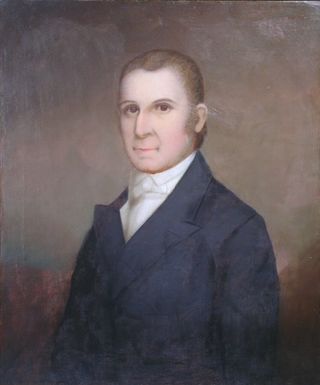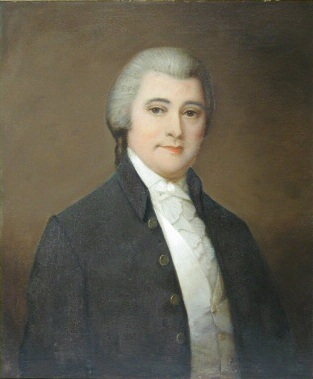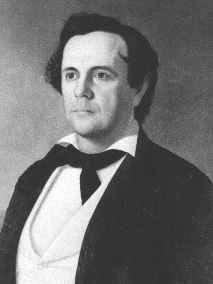Related Research Articles

Knox County is located in the U.S. state of Tennessee. As of the 2020 census, the population was 478,971, making it the third-most populous county in Tennessee. Its county seat is Knoxville, which is the third-most populous city in Tennessee. Knox County is included in the Knoxville metropolitan area. The county is located at the geographical center of the Great Valley of East Tennessee. Near the heart of the county is the origin of the Tennessee River, at the confluence of the Holston and French Broad rivers.

Elizabethton is a city in, and the county seat of Carter County, Tennessee, United States. Elizabethton is the historical site of the first independent American government located west of both the Eastern Continental Divide and the original Thirteen Colonies.

Willie Blount was an American politician who served as the third Governor of Tennessee from 1809 to 1815. Blount's efforts to raise funds and soldiers during the War of 1812 earned Tennessee the nickname, "Volunteer State." He was the younger half-brother of Southwest Territory governor, William Blount. He was a member of the Democratic-Republican Party.

William Blount was an American politician, landowner and Founding Father who was one of the signers of the Constitution of the United States. He was a member of the North Carolina delegation at the Constitutional Convention of 1787 and led the efforts for North Carolina to ratify the Constitution in 1789 at the Fayetteville Convention. He then served as the only governor of the Southwest Territory and played a leading role in helping the territory gain admission to the union as the state of Tennessee. He was selected as one of Tennessee's initial United States Senators in 1796, serving until he was expelled for treason in 1797.
The State of Franklin was an unrecognized proposed state located in present-day East Tennessee, in the United States. Franklin was created in 1784 from part of the territory west of the Appalachian Mountains that had been offered by North Carolina as a cession to Congress to help pay off debts related to the American War for Independence. It was founded with the intent of becoming the 14th state of the new United States.

The Territory South of the River Ohio, more commonly known as the Southwest Territory, was an organized incorporated territory of the United States that existed from May 26, 1790, until June 1, 1796, when it was admitted to the United States as the State of Tennessee. The Southwest Territory was created by the Southwest Ordinance from lands of the Washington District that had been ceded to the U.S. federal government by North Carolina. The territory's lone governor was William Blount.
William Grainger Blount was an American politician who represented Tennessee's 2nd district in the United States House of Representatives from 1815 to 1819. He is the son of Southwest Territory governor William Blount and nephew of Tennessee governor Willie Blount, serving under the latter as Tennessee Secretary of State from 1811 to 1815.

Newton Cannon was an American politician who served as the eighth Governor of Tennessee from 1835 to 1839. He also served several terms in the United States House of Representatives, from 1814 to 1817, and from 1819 to 1823. Cannon was a long-time foe of Andrew Jackson, and spent much of his political career opposing Jacksonite policies. Cannon was succeeded as Governor of Tennessee by James K. Polk in 1839, who later became President of the United States.

Alfred Alexander Taylor, known as Alf Taylor, was an American politician and lecturer from eastern Tennessee. He served as the 34th governor of Tennessee from 1921 to 1923, one of three Republicans to hold the position from the end of Reconstruction to the latter half of the 20th century. He also served three terms in the U.S. House of Representatives, from 1889 to 1895.

William Cocke was an American lawyer, pioneer, and statesman. He has the distinction of having served in the state legislatures of four different states: Virginia, North Carolina, Tennessee, and Mississippi, and was one of the first two United States senators for Tennessee.

Robert Love Taylor was an American politician, writer, and lecturer. A member of the Democratic Party, he served three terms as the 24th governor of Tennessee, from 1887 to 1891, and again from 1897 to 1899, and subsequently served as a United States senator from 1907 until his death. He also represented Tennessee's 1st district in the United States House of Representatives from 1879 to 1881, the last Democrat to hold the district's seat.
William Blount Carter was an American politician who represented Tennessee's first district in the United States House of Representatives.

Nathaniel Green Taylor was an American lawyer, farmer, and politician from Tennessee. He was U.S. Representative from Tennessee from 1854 to 1855, and again from 1866 to 1867, and Commissioner of Indian Affairs from 1867 to 1869.

The Blount Mansion, also known as William Blount Mansion, located at 200 West Hill Avenue in downtown Knoxville, Tennessee, was the home of the only territorial governor of the Southwest Territory, William Blount (1749–1800). Blount, a Founding Father of the United States, a signer of the United States Constitution, and a U.S. Senator from Tennessee, lived on the property with his family and ten African-American slaves. The mansion served as the de facto capitol of the Southwest Territory. In 1796, much of the Tennessee Constitution was drafted in Governor Blount's office at the mansion. Tennessee state historian John Trotwood Moore once called Blount Mansion "the most important historical spot in Tennessee."

Col. Landon Carter, I was an American planter and burgess for Richmond County, Virginia. Although one of the most popular patriotic writers and pamphleters of pre-Revolutionary and Revolutionary-era Virginia, he may today be perhaps best known for his journal, which described colonial life leading up the American War of Independence, The Diary of Colonel Landon Carter.

The Craighead–Jackson House is a historic two-story, brick house in Knoxville, in the U.S. state of Tennessee. The home was constructed by John Craighead in 1818 across the street from the William Blount Mansion. The house is on the National Register of Historic Places.

Rev. William Blount Carter was a farmer, an American Presbyterian minister, and the mastermind of the East Tennessee Bridge Burnings, a guerrilla-warfare action of the American Civil War. Per one history, "Whatever else may be said about the burning of the bridges of the East Tennessee and Virginia Railroad in November, 1861, there can be no doubt whatever that the plan was conceived by the Rev. William B. Carter, of Elizabethton, Tenn., and it was through his influence that Mr. Lincoln and the War Department sanctioned it and pledged the cooperation of the Government in the execution of his plans." Carter was otherwise known as a "highly educated, cultured Christian gentleman, a minister of the Presbyterian church, and highly respected by all who knew him."

Sycamore Shoals State Historic Area is a state park located in Elizabethton, in the U.S. state of Tennessee. The park consists of 70 acres (28.3 ha) situated along the Sycamore Shoals of the Watauga River, a National Historic Landmark where a series of events critical to the establishment of the states of Tennessee and Kentucky, and the settlement of the Trans-Appalachian frontier in general, took place. Along with the historic shoals, the park includes a visitor center and museum, the reconstructed Fort Watauga, the Carter House and Sabine Hill . For over a thousand years before the arrival of European explorers, Sycamore Shoals and adjacent lands had been inhabited by Native Americans. The first permanent European settlers arrived in 1770, and established the Watauga Association—one of the first written constitutional governments west of the Appalachian Mountains—in 1772. Richard Henderson and Daniel Boone negotiated the Treaty of Sycamore Shoals in 1775, which saw the sale of millions of acres of Cherokee lands in Kentucky and Tennessee and led to the building of the Wilderness Road. During the American Revolution, Sycamore Shoals was both the site of Fort Watauga, where part of a Cherokee invasion was thwarted in 1776, and the mustering ground for the Overmountain Men in 1780.

Mary Boyce Temple was an American philanthropist and socialite, active primarily in Knoxville, Tennessee, in the late 19th and early 20th centuries. She was the first president of the Ossoli Circle, the oldest federated women's club in the South, and published a biography of the club's namesake, Margaret Fuller Ossoli, in 1886. She also cofounded the Tennessee Woman's Press and Author's Club, the Knoxville Writer's Club, and the Knox County chapter of the League of Women Voters. She represented Tennessee at various international events, including the Paris Exposition of 1900 and at the dedication of the Panama Canal in 1903.
References
- 1 2 "Historic Sword Presented". The Journal and Tribune. 1910-06-04. p. 5. Retrieved 2023-07-17.
- ↑ "The Carter Mansion". Carter County Area History. Retrieved 2023-07-17.
- ↑ Rust, Randal. "Carter, Landon". Tennessee Encyclopedia. Retrieved 2023-07-17.
- ↑ "The Mansion". Carter County Area History. Retrieved 2023-07-17.
- 1 2 3 "Carter Family". www.anamericanfamilyhistory.com. Retrieved 2023-07-17.
- 1 2 3 Moore, John Trotwood; Foster, Austin Powers (1923). Tennessee, the Volunteer State, 1769-1923. S. J. Clarke Publishing Company. p. 570.